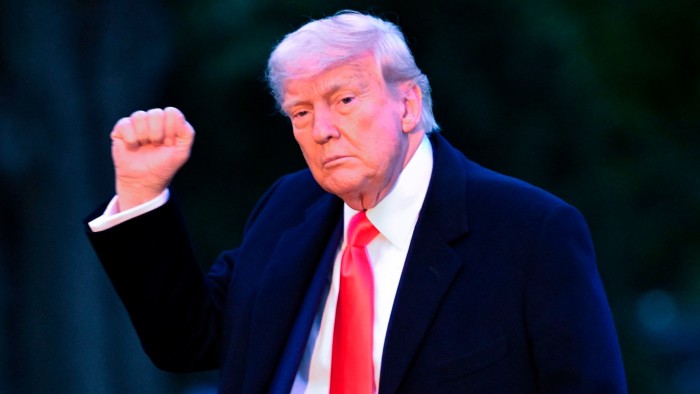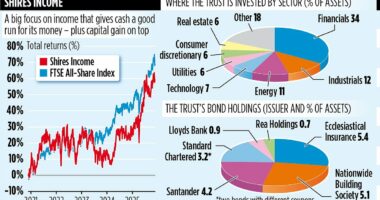Share this @internewscast.com
Unlock the White House Watch newsletter for free
Donald Trump declared he was “not looking for a deal” with the EU shortly after unveiling plans to implement a 50 percent tariff on European imports next month.
In a Truth Social post on Friday, the US President criticized the EU for what he claimed were unfair trade practices and mentioned that negotiations for a new agreement were unsuccessful.
“Therefore I am recommending a straight 50% Tariff on the European Union, starting on June 1, 2025.”
The EU responded later on Friday, asserting it would “defend our interests.” Maroš Šefčovič, the bloc’s trade commissioner, emphasized on X after a conversation with US officials, “EU-US trade is unmatched and must be guided by mutual respect, not threats.”
Šefčovič added the he was “committed to securing a deal that works for both”.
Trump’s comments escalated the stand-off with the EU barely two weeks after the US agreed with China to slash tariffs in a pact that comforted global investors.
Asked by reporters in the Oval Office if he was using the new tariff threat to force the EU into a deal, Trump said: “I mean, we’ve set the deal. It’s at 50 per cent.”
He added that he “didn’t know” if the EU could do anything to avoid the new levy, although he would consider a “little bit of a delay” if European companies committed to move manufacturing to the US.
“We’re going to see what happens. But right now it’s going on on June 1, and that’s the way it is.”
Trump’s latest tariff threats sent stock prices and the dollar lower, and ended weeks of relative calm in markets after he retreated from a trade war with China that economists said would push up US inflation and hit growth.
A 50 per cent tariff on the EU would be more than double the tariff rate he announced for the bloc on his self-styled “liberation day” on April 2, and could reduce German GDP by 1.7 per cent over three years, according to Capital Economics.
But Scott Bessent, the US Treasury secretary, suggested the threats were designed to put pressure on Brussels to agree a new trade pact, in contrast with Trump’s comments that Washington wasn’t looking for an agreement.
“I think this is in response just to the EU’s pace,” Bessent told Fox News. “I would hope that this would light a fire under the EU.”
In another interview with Bloomberg TV he said he expected the US to seal “several large deals” over the next couple of weeks.

Friday’s tariff threats from Trump blindsided European officials, after cordial talks with the US at this week’s G7 finance ministers summit in the Canadian Rockies.
The US was “treating us like friends again”, said one European official.
Stock markets also reacted to a separate threat by Trump to hit Apple with new tariffs unless it agreed to make its iPhones in the US. The S&P 500 closed 0.7 per cent lower on Friday, having recovered from a steeper decline at the opening bell. The Stoxx Europe 600 closed 0.9 cent lower.
Austan Goolsbee, president of the Chicago Fed and a voter on US interest rates, told CNBC on Friday that the 50 per cent tariff on the EU and another 25 per cent levy Trump threatened on Apple “would be really scary for the supply chain” and had raised the bar for US rate cuts “a little higher”.
The move “puts a dent in the view that markets will rein in Trump”, said Andrew Pease, chief investment strategist at Russell Investments.
The US imposed a 20 per cent “reciprocal” rate on most EU goods in April, but halved it until July 8 to allow time for talks. It has retained 25 per cent levels on steel, aluminium and car parts and is promising similar action on pharmaceuticals, semiconductors and other goods.
The bloc must now choose whether to retaliate with counter-tariffs or accede to US demands to make concessions.
Member states have approved a €21bn package of up to 50 per cent tariffs from July 14 on US items such as maize, wheat, motorcycles and clothing. The European Commission is also consulting on a €95bn list of other targets including Boeing aircraft, cars and bourbon whiskey.
Exporters and stocks linked to the health of the European economy were hit hard by Trump’s threats, with carmaker Stellantis dropping 4.6 per cent and Deutsche Bank shedding 4.2 per cent.
Traders moved to price in faster interest rate cuts from the European Central Bank to support a tariff-hit economy.
“This is a reminder that the trade uncertainty is in no way over,” said Kasper Elmgreen, chief investment officer for fixed income and equities at Nordea Asset Management. “Every day that we don’t have a deal, we risk serious economic damage.”
Additional reporting by Emily Herbert, Peter Foster, Claire Jones and Myles McCormick












